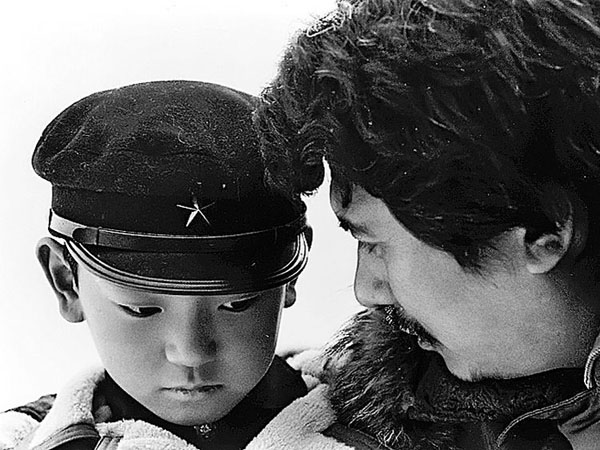“Nagisa Oshima was a master at jolting viewers,” begins Aaron Cutler. “The great Japanese filmmaker, who died last year at age 90, employed shocking cuts and startling angles to go with his films’ messages. In Violence at Noon (1966), a serial rapist is the product of a patriarchal society; in Death by Hanging (1968), a murderer awaiting execution is a victim of the State. Oshima’s 1969 feature Boy often looks and feels like a normal—even comforting—film, initially unfolding in color ‘Scope shots of lyrical beauty. This beauty, however, fades and grows distorted over time.”
For Budd Wilkins, writing for Slant, “Boy has the ‘ripped from the headlines’ appeal of a timely social-problem film, recounting three months in the life of a struggling family (disabled veteran father, young stepmother, two children) that looks to get ahead by faking car accidents and blackmailing motorists into a hasty payoff, as seen through the eyes of the titular 10-year-old, complete with occasional voiceover narration…. Oshima steadily introduces little quirks into the ostensibly simple narrative: abrupt shifts in film stock, the use of distorting fisheye lenses, sudden disjunctions between sound and image. These cinematic tics serve to remind viewers that the screen is a canvas and not a window.”
“American audiences weaned on little rascals and underage bicycle thieves would be used to seeing prepubescents participating in less-than-legal activities, and late ’60s arthouse crowds had already sampled delicacies from the Land of the Rising Sun,” writes David Fear in the Voice. “But 1969’s Boy was something altogether different, a bracing slap that required viewers to fill in the social-issue blanks. The head enfant terrible of a Japanese New Wave that hadn’t quite made it West yet, Oshima was the polar opposite of a user-friendly artist like Akira Kurosawa; he was more likely to ape Buñuel‘s pitiless shock-and-awe tactics than craft import-ready tales about the Bushido code…. This is what contemporary Japan looks like, it says: Not pillow shots and sword fights, just a country populated largely by predators and prey.”
For Time Out New York‘s Keith Uhlich, this is “the kind of cynicism that invigorates and energizes—a bracing dose of misanthropy that is nonetheless suffused with robust empathy for its hardened juvenile protagonist.”
“Boy flirts with the surreal,” writes Daniel Guzmán at Cinespect. “The music has the ominous tone of a Hitchcock film, despite seemingly innocent visuals of a boy at play. Even his casting of the titular child is a surreal choice. Tetsuo [Abe] is a real-life orphan, discovered in a search through various children’s homes. Casting him was a brilliant decision, as his stoicism is a perfect contrast to the behavior of his raging, calculating father.”
“[A]s the action ranges along picturesque towns on Japan’s western coast and north to snowbound Hokkaido, Oshima depicts them sumptuously, contemplating teeming cityscapes and desolate byways in coolly ravishing wide-screen images even while filling them with scenes of crime and cruelty,” writes the New Yorker‘s Richard Brody.
Boy opens today for a one-week run at New York’s Film Forum.
For news and tips throughout the day every day, follow @KeyframeDaily on Twitter and/or the RSS feed. Get Keyframe Daily in your inbox by signing in at fandor.com/daily.




